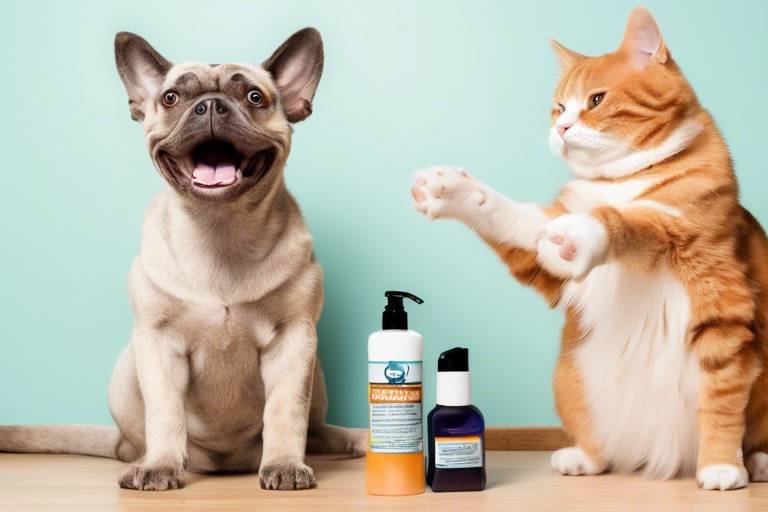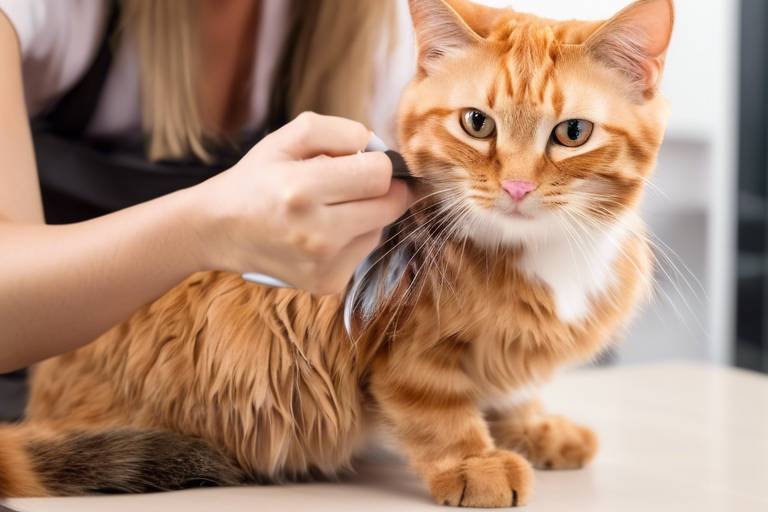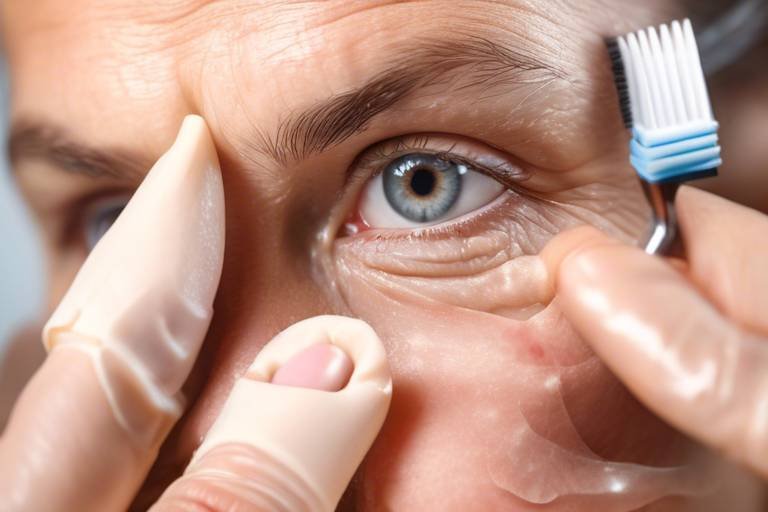How to Spot and Treat Fleas and Ticks During Grooming
As a pet owner, nothing is more distressing than realizing your furry friend is dealing with fleas or ticks. These pesky parasites can cause significant discomfort for your pet and lead to serious health issues if left untreated. That's why understanding how to spot and treat them during grooming sessions is crucial. Grooming isn’t just about keeping your pet looking sharp; it’s a golden opportunity to check for any signs of infestation. In this article, we’ll explore how to effectively identify and manage fleas and ticks, ensuring a healthier and more comfortable experience for both you and your beloved pet.
Fleas and ticks are two of the most common parasites that can affect pets. Fleas are tiny, wingless insects that thrive on the blood of their hosts, while ticks are arachnids that latch onto the skin and can transmit diseases. Understanding their characteristics is essential for effective treatment and prevention. Fleas are known for their rapid reproduction, and a single female flea can lay thousands of eggs in her lifetime. Ticks, on the other hand, can carry diseases such as Lyme disease and Rocky Mountain spotted fever, making them particularly dangerous. Knowing what these pests look like and how they behave can give you the upper hand during grooming sessions.
Identifying signs of flea and tick infestations is essential for timely intervention. During grooming, keep an eye out for symptoms such as excessive scratching, biting, and even visible pests in your pet's fur. If your pet seems to be more restless than usual or is constantly trying to bite or scratch at their skin, it could be a sign that something is amiss. Here are some common indicators to look for:
- Behavioral Changes: Increased agitation, restlessness, and unusual grooming habits can indicate the presence of fleas or ticks.
- Physical Symptoms: Look for hair loss, redness, or skin infections that may arise due to flea or tick bites.
- Visible Pests: Finding fleas or ticks on your pet’s coat is a clear indication of an infestation.
Utilizing specific grooming techniques can enhance the detection of fleas and ticks. Techniques such as thorough brushing and using a fine-toothed comb can help reveal hidden pests. When grooming, consider the following methods:
- Brush Thoroughly: Use a slicker brush or a flea comb to go through your pet's fur. This helps to dislodge any fleas or ticks that may be hiding.
- Inspect Carefully: Pay special attention to areas where fleas tend to hide, such as behind the ears, under the legs, and around the tail.
Once you’ve identified fleas or ticks on your pet, it’s crucial to act quickly. There are various treatment options available to eliminate these parasites and alleviate your pet's discomfort. Here are some popular methods:
Topical treatments are a popular choice for managing fleas and ticks. These solutions are applied directly to your pet's skin and can provide long-lasting protection against infestations. They are easy to apply and can often be found at your local pet store or vet's office.
Oral medications offer another effective method for treating flea and tick infestations. These medications work systemically, targeting pests from within and preventing future outbreaks. They can be a convenient option for many pet owners, as they often require only a monthly dosage.
Prevention is key to keeping fleas and ticks at bay. By implementing regular grooming routines and using preventative products, you can significantly reduce the risk of infestations. Here are some tips:
Establishing a regular grooming schedule helps maintain your pet's coat and skin health. Frequent grooming sessions make it easier to spot and address any signs of pests. Aim for at least once a week, but more frequent sessions may be necessary during peak flea and tick seasons.
Managing your pet's environment is crucial for flea and tick prevention. Regularly cleaning living spaces and treating outdoor areas can minimize the risk of these parasites affecting your pet. Vacuum carpets, wash pet bedding, and consider using flea treatments in your yard to keep these pests at bay.
1. How often should I groom my pet to check for fleas and ticks?
It’s best to groom your pet at least once a week, especially during peak flea and tick seasons.
2. What are the best treatments for fleas and ticks?
Topical treatments and oral medications are both effective options. Consult your vet for recommendations based on your pet's specific needs.
3. Can fleas and ticks affect humans?
Yes, fleas can bite humans and cause irritation, while ticks can transmit diseases to humans as well. It’s important to keep your living environment clean and treat your pets regularly.

Understanding Fleas and Ticks
This article provides essential tips for pet owners on identifying and managing fleas and ticks during grooming sessions, ensuring a healthier and more comfortable experience for both pets and their owners.
Fleas and ticks are not just pesky little creatures; they are common parasites that can wreak havoc on your beloved pets. Understanding these nuisances is crucial for any pet owner who wants to ensure the well-being of their furry friends. Fleas are tiny, wingless insects that thrive on the blood of mammals and birds. They can jump remarkably high—up to 150 times their own body length—making them hard to catch and even harder to get rid of. On the other hand, ticks are arachnids that latch onto your pet's skin to feed on their blood, often going unnoticed until they have already caused harm. Both of these parasites can lead to serious health issues, including allergic reactions, skin infections, and even transmission of diseases.
To effectively manage fleas and ticks, you need to recognize their characteristics. Fleas are typically reddish-brown and about 1/8 inch long, with a flat body that allows them to move quickly through fur. Ticks, in contrast, can vary in size from a pinhead to as large as a marble, depending on how much they've fed. They often appear grayish or brown, and their bodies swell as they engorge with blood.
When grooming your pet, it's essential to look for specific signs of these parasites. For instance, flea dirt—tiny black specks that resemble pepper—can often be found on your pet's skin or fur. Ticks may appear as small bumps, and they can be particularly hard to spot if they are embedded in the skin. Regular grooming not only helps you maintain your pet's coat but also allows you to check for these unwanted guests.
Here’s a quick comparison of the two:
| Characteristic | Fleas | Ticks |
|---|---|---|
| Type | Insect | Arachnid |
| Size | 1/8 inch | Pinhead to marble |
| Feeding Method | Jump and bite | Latch and suck |
| Health Risks | Allergic reactions, skin infections | Lyme disease, Rocky Mountain spotted fever |
By understanding the nature of fleas and ticks, you can take proactive steps to protect your pets. Remember, the sooner you identify these parasites, the easier it will be to manage them. So, keep your eyes peeled and your grooming tools handy!
Identifying signs of flea and tick infestations is essential for timely intervention. Look for symptoms such as excessive scratching, biting, and visible pests in your pet's fur during grooming.
Pets may exhibit behavioral changes when infested with fleas or ticks. Increased agitation, restlessness, and unusual grooming habits can indicate the presence of these parasites.
Physical symptoms like hair loss, redness, and skin infections may arise due to flea or tick bites. Observing these signs during grooming can help in early detection.
Finding fleas or ticks on your pet's coat is a clear indication of an infestation. Regular grooming allows for closer inspection and the opportunity to remove these pests promptly.
Utilizing specific grooming techniques can enhance the detection of fleas and ticks. Techniques such as thorough brushing and using a fine-toothed comb can help reveal hidden pests.
Once fleas or ticks are identified, effective treatment options must be employed. Various products and methods are available to eliminate these parasites and alleviate your pet's discomfort.
Topical treatments are popular for managing fleas and ticks. These solutions are applied directly to the skin and can provide long-lasting protection against infestations.
Oral medications offer another effective method for treating flea and tick infestations. These medications work systemically, targeting pests from within and preventing future outbreaks.
Prevention is key to keeping fleas and ticks at bay. Implementing regular grooming routines and using preventative products can significantly reduce the risk of infestations.
Establishing a regular grooming schedule helps maintain your pet's coat and skin health. Frequent grooming sessions make it easier to spot and address any signs of pests.
Managing your pet's environment is crucial for flea and tick prevention. Regularly cleaning living spaces and treating outdoor areas can minimize the risk of these parasites affecting your pet.
Q: How often should I groom my pet to check for fleas and ticks?
A: It's best to groom your pet at least once a week. This will help you catch any infestations early.
Q: Can fleas and ticks affect indoor pets?
A: Yes, fleas and ticks can easily enter your home through clothing or other pets, making indoor pets susceptible to infestations.
Q: What should I do if I find a tick on my pet?
A: Remove the tick carefully with tweezers, pulling straight out without twisting. Clean the area and monitor for any signs of infection.

Signs of Infestation
When it comes to our furry friends, spotting signs of flea and tick infestations is crucial for their well-being. These pesky parasites can cause a range of discomforts, and being vigilant can save your pet from unnecessary suffering. One of the first things to watch for is excessive scratching. If your pet seems to be scratching more than usual, it's a red flag. Think of it as your pet's way of waving a little flag of distress. They might be trying to tell you something isn't right!
Another common symptom is biting at their fur. If you catch your pet gnawing at their skin, it could be an indication that they’re trying to rid themselves of these irritating invaders. During grooming, take a moment to observe their behavior closely. Are they fidgety or restless? These behavioral changes can signal that something is bothering them, and it might just be those little bloodsuckers.
Physical symptoms are also significant indicators of an infestation. Look for signs like hair loss or redness in the skin. These can be caused by flea or tick bites, and if you notice any skin infections, it's time to take action. Regular grooming sessions provide the perfect opportunity to check for these issues. You can think of grooming as a health check-up for your pet, allowing you to keep an eye on their skin and coat condition.
Lastly, if you find visible pests in your pet's coat, such as fleas or ticks, that’s a clear sign of an infestation. They can often be seen scurrying around or clinging to the fur. If you see one, it’s likely there are more hiding nearby. Regular grooming allows for a thorough inspection, making it easier to spot these unwelcome guests and remove them promptly.
To summarize, here are the key signs to look out for during grooming:
- Excessive scratching
- Biting at fur
- Behavioral changes
- Physical symptoms like hair loss and redness
- Visible pests in the coat
By being attentive to these signs, you can ensure that your pet remains healthy and happy. Remember, early detection is key in preventing a minor issue from turning into a major infestation!
Q: How often should I groom my pet to check for fleas and ticks?
A: It's recommended to groom your pet at least once a week. However, during flea and tick season, more frequent grooming may be necessary.
Q: Can fleas and ticks affect indoor pets?
A: Yes, fleas and ticks can affect indoor pets as well. They can be brought inside on clothing or other pets, so regular checks are essential.
Q: What should I do if I find fleas or ticks on my pet?
A: If you find fleas or ticks, use a fine-toothed comb to remove them and consult your veterinarian for appropriate treatment options.
Q: Are there any natural remedies for preventing fleas and ticks?
A: Some natural remedies include using essential oils like lavender or cedar, but always consult your vet before trying new treatments to ensure they are safe for your pet.
Behavioral Changes
When your furry friend starts acting a bit out of the ordinary, it might be more than just a case of the grumps. Fleas and ticks can cause significant discomfort, leading to noticeable behavioral changes. For instance, you might notice your pet scratching more than usual, as if they've got an itch that just won't quit. This incessant scratching isn't just a nuisance; it's their way of expressing irritation caused by these pesky parasites.
Additionally, you might observe increased agitation or restlessness. Imagine feeling itchy and uncomfortable all day long—it's no wonder your pet might be pacing around or unable to settle down. They might also start to exhibit unusual grooming habits, such as over-grooming specific areas of their body, which can lead to hair loss and even skin infections. This obsessive grooming is often a desperate attempt to relieve the irritation caused by fleas or ticks.
It's important to keep an eye on your pet's behavior, as these changes can serve as early warning signs of an infestation. If you notice your pet constantly trying to bite at their skin or fur, it could indicate that they're trying to rid themselves of these unwelcome guests. The sooner you catch these signs, the quicker you can take action to help your pet feel comfortable again.
In summary, here are some key behavioral changes to watch for:
- Excessive scratching or biting at the skin
- Restlessness and inability to settle down
- Unusual grooming habits, especially focused on certain areas
- Signs of agitation or distress
By staying vigilant during grooming sessions, you can catch these behavioral changes early and take the necessary steps to treat any flea or tick infestations, ensuring your pet remains happy and healthy.
Q: How can I tell if my pet has fleas or ticks?
A: Look for signs such as excessive scratching, biting, and visible pests in their fur. Behavioral changes like restlessness can also indicate an infestation.
Q: What should I do if I find fleas or ticks on my pet?
A: It's essential to act quickly. You can use topical treatments or oral medications, and consult your veterinarian for the best course of action.
Q: How often should I groom my pet to prevent fleas and ticks?
A: Establishing a regular grooming schedule is crucial. Aim for at least once a week, but adjust based on your pet's needs and environment.
Q: Can fleas and ticks affect my pet's health?
A: Yes, they can lead to discomfort, skin infections, and even more severe health issues if left untreated. Regular grooming and preventive measures are key to keeping your pet healthy.
Physical Symptoms
When it comes to identifying flea and tick infestations, being vigilant about is crucial. These parasites can wreak havoc on your pet's health, leading to various visible signs that can easily be spotted during grooming sessions. One of the most common symptoms is hair loss. You might notice patches of fur missing or thinning areas on your pet's body, which can be a direct result of constant scratching or biting at the infested areas. Fleas and ticks can cause your pet to feel incredibly uncomfortable, leading to excessive grooming and, subsequently, hair loss.
Another significant sign to look for is redness and irritation on the skin. When fleas bite, they can cause allergic reactions, leading to inflamed skin that may appear red and sore. This irritation can be accompanied by scabs or sores, which can become infected if not treated promptly. During grooming, it's essential to run your fingers through your pet's coat and check for any unusual bumps or sensitive spots that could indicate a problem.
Additionally, keep an eye out for skin infections. If you notice that your pet has developed a persistent itch or seems to be in pain, it may be due to a secondary infection caused by scratching at flea bites. These infections can be serious and may require veterinary intervention. Regular grooming not only helps in identifying these issues early but also allows you to take immediate action to alleviate your pet's discomfort.
To summarize, here are some key physical symptoms to watch for during grooming:
- Hair Loss: Patches of fur missing or thinning areas.
- Redness and Irritation: Inflamed skin that appears red and sore.
- Scabs and Sores: Resulting from scratching and biting.
- Skin Infections: Persistent itching and pain indicating possible infection.
Being proactive and observant during grooming sessions can make a significant difference in your pet's health. If you notice any of these symptoms, it’s wise to consult your veterinarian for appropriate treatment options. Remember, early detection is key to ensuring your furry friend remains happy and healthy!
Q: How often should I groom my pet to check for fleas and ticks?
A: It’s recommended to groom your pet at least once a week, but more frequent grooming may be necessary during flea and tick season.
Q: What should I do if I find fleas or ticks on my pet?
A: If you discover fleas or ticks, use appropriate treatments such as topical solutions or oral medications, and consult your veterinarian for the best course of action.
Q: Can fleas and ticks affect my home environment?
A: Yes, fleas and ticks can infest your home, so it's essential to treat your living spaces and outdoor areas to prevent re-infestation.
Q: Are there natural remedies to prevent fleas and ticks?
A: Some natural remedies include essential oils, diatomaceous earth, and regular cleaning. However, consult your vet before using any natural products.
Visible Pests
When it comes to identifying flea and tick infestations, the most straightforward method is spotting the pests themselves. Fleas are tiny, dark brown insects that can jump several inches, making them quite elusive. They are about 1/8 inch long, and their flattened bodies allow them to move quickly through your pet’s fur. On the other hand, ticks are larger, oval-shaped creatures that can range in size from a pinhead to a grape, depending on how much they've fed. Ticks can be particularly tricky because they often attach themselves to the skin and may go unnoticed until they’ve had their fill.
During grooming sessions, it's essential to maintain a keen eye for these visible pests. Here are some tips to help you spot them:
- Check the Fur: Gently part your pet's fur and inspect the skin closely. Look for any moving specks, which could be fleas, or dark spots, which may be flea dirt (digested blood).
- Look for Ticks: Ticks often attach themselves in warm areas such as behind the ears, under the legs, or around the tail. Feel for any unusual lumps or bumps, which could indicate a tick.
- Use a Fine-Toothed Comb: A fine-toothed comb can be incredibly effective in catching fleas and ticks. Comb through your pet's fur, especially near the skin, and inspect the comb for any pests.
Finding fleas or ticks during grooming is a crucial step in managing their presence. If you spot a flea, it’s important to act quickly, as these pests reproduce rapidly. A single female flea can lay up to 50 eggs per day, leading to a full-blown infestation in no time. Ticks, on the other hand, can transmit various diseases, including Lyme disease and Rocky Mountain spotted fever, making it even more critical to remove them promptly.
Once you identify visible pests, ensure you have the right tools ready for removal. For fleas, a flea shampoo or a flea comb can help remove them from your pet’s coat. For ticks, use fine-tipped tweezers to grasp the tick as close to the skin as possible and pull upward with steady, even pressure. Avoid twisting or jerking the tick, as this can cause parts of it to break off and remain in the skin.
In summary, regularly checking for visible pests during grooming not only helps in early detection but also contributes significantly to your pet’s overall health and comfort. By being vigilant and proactive, you can ensure a happier, healthier life for your furry friend.
- How often should I groom my pet to check for fleas and ticks? Regular grooming should be done at least once a week, but more frequent grooming is recommended during peak flea and tick seasons.
- What should I do if I find fleas or ticks on my pet? If you find fleas, use a flea treatment product and consult your veterinarian for the best options. For ticks, remove them carefully using tweezers and monitor your pet for any signs of illness.
- Can fleas and ticks affect humans? Yes, both fleas and ticks can bite humans and transmit diseases, so it’s essential to manage infestations promptly.
Grooming Techniques for Detection
When it comes to keeping your furry friend safe from fleas and ticks, grooming is not just about keeping them looking good; it’s also a crucial time for detection. Think of grooming as a treasure hunt, where the goal is to uncover hidden pests before they can cause any harm. To enhance your chances of spotting these pesky parasites, there are several effective grooming techniques you can employ.
First and foremost, invest in a good quality fine-toothed comb. This tool is your best friend when it comes to detecting fleas and ticks. As you run the comb through your pet's fur, pay close attention to the areas where these parasites love to hide, such as behind the ears, around the neck, and under the belly. Fleas are small, dark, and agile, making them difficult to spot with the naked eye. However, a fine-toothed comb can help you catch them in the act.
Another technique to consider is thorough brushing. Use a slicker brush or a bristle brush to remove loose fur and debris, which can also dislodge fleas and ticks. As you brush, maintain a gentle yet firm pressure, ensuring you’re reaching the skin underneath the coat. This method not only helps you detect pests but also promotes healthy skin and fur by distributing natural oils.
Moreover, consider the “white towel test”. This simple trick involves grooming your pet over a white towel or surface. As you comb or brush, any fleas or flea dirt (which looks like tiny black specks) will fall onto the towel, making them easier to spot. If you notice any reddish-brown stains on the towel after grooming, it’s a telltale sign that your pet may have fleas, as this is the result of digested blood.
Don't forget to check your pet’s skin and coat closely. Fleas and ticks can sometimes cause irritation that leads to skin infections or hotspots. During grooming, look for signs of redness, swelling, or unusual bumps. If you notice any of these symptoms, it’s essential to consult your veterinarian for further evaluation and treatment.
In summary, by incorporating these grooming techniques into your routine, you’re not just pampering your pet; you’re actively participating in their health and well-being. Regular grooming sessions will not only help you detect fleas and ticks but also strengthen the bond between you and your pet. Remember, a little extra time spent grooming can make all the difference in keeping your beloved companion comfortable and healthy.
- How often should I groom my pet for flea and tick detection?
It's recommended to groom your pet at least once a week, but more frequent grooming may be necessary during peak flea and tick seasons. - What should I do if I find fleas or ticks on my pet?
Immediately consult your veterinarian for appropriate treatment options and consider using topical or oral medications for prevention. - Can I prevent fleas and ticks with grooming alone?
While grooming is essential for detection, it should be combined with preventative treatments and regular cleaning of your pet's environment.

Treatment Options
Once you've identified that your furry friend has been invaded by fleas or ticks, the next step is to take action with effective treatment options. It's crucial to act swiftly, as these pesky parasites can cause not only discomfort but also lead to serious health issues if left untreated. Fortunately, there are various methods available to help you eliminate these unwelcome guests and restore your pet's comfort.
One of the most common and effective treatment options is topical treatments. These solutions are typically applied directly to your pet's skin, usually between the shoulder blades or at the base of the neck, where they can't lick it off. Topical treatments come in various forms, including spot-on treatments, sprays, and powders. They work by either repelling fleas and ticks or killing them upon contact. The convenience of these products is that they often provide long-lasting protection, making them a favorite among pet owners.
In addition to topical treatments, oral medications are another powerful option for managing flea and tick infestations. These medications are ingested by your pet and work systemically, meaning they enter the bloodstream and target pests from the inside out. This method not only kills adult fleas and ticks but also helps prevent future outbreaks. It's essential to consult your veterinarian to determine the best oral medication for your pet, as different products may have varying active ingredients and dosages.
When considering treatment options, it's also important to think about the lifecycle of fleas and ticks. Many products focus solely on adult pests, but it's crucial to eradicate eggs and larvae as well. Therefore, a combination of treatments may be necessary. For instance, using a topical treatment alongside a household spray can help eliminate fleas and ticks at all stages of their lifecycle.
Here's a quick comparison of the two popular treatment options:
| Treatment Type | Form | Duration of Effectiveness | Application Method |
|---|---|---|---|
| Topical Treatments | Spot-on, Spray, Powder | 1 month (varies by product) | Applied directly to the skin |
| Oral Medications | Tablets, Chews | 1 month (varies by product) | Administered orally |
It's also worth mentioning that some pet owners may prefer natural treatments. While these can be effective, they often require more frequent application and may not provide the same level of protection as conventional treatments. Essential oils, diatomaceous earth, and herbal remedies are popular among those looking for a more holistic approach. However, always consult your veterinarian before introducing any natural products, as some can be harmful to pets.
Regardless of the treatment you choose, always follow the manufacturer's instructions and consult with your veterinarian to ensure the safety and effectiveness of the products you use. Remember, treating fleas and ticks is not just about your pet's comfort; it's also about protecting your home and family from these parasites.
- How often should I treat my pet for fleas and ticks? It depends on the product used. Most topical treatments are effective for about a month, while oral medications can vary. Always check the label for specific instructions.
- Can I use flea and tick treatments on puppies or kittens? Yes, but it's crucial to use products specifically formulated for their age and weight. Consult your veterinarian for recommendations.
- What should I do if my pet has a severe infestation? If your pet is severely infested, it's best to consult your veterinarian for a tailored treatment plan. They may recommend a combination of products and additional measures to ensure complete eradication.
Topical Treatments
When it comes to managing flea and tick infestations, are a go-to solution for many pet owners. These treatments are designed to be applied directly to your pet's skin, where they can work their magic to eliminate these pesky parasites. One of the biggest advantages of topical treatments is their long-lasting protection. Typically, these solutions can provide effective coverage for up to a month, which means fewer applications and less hassle for you and your furry friend.
Topical treatments come in various forms, including spot-on treatments, sprays, and gels. Spot-on treatments are particularly popular because they are easy to apply. You simply part your pet's fur at the base of the neck or between the shoulder blades and squeeze the solution onto the skin. This ensures that your pet cannot lick it off, maximizing its effectiveness. The active ingredients in these treatments often include ingredients like fipronil or imidacloprid, which target fleas and ticks effectively.
It's also important to note that different products may have varying active ingredients, which can affect their effectiveness against different life stages of fleas and ticks. For instance, some treatments are designed to kill adult fleas, while others may also target flea eggs and larvae. Therefore, when selecting a topical treatment, consider your pet's specific needs and any existing infestations in your home.
While topical treatments are generally safe, it's crucial to follow the manufacturer's instructions carefully. Over-application or using a product not intended for your pet's size or species can lead to adverse reactions. Always consult your veterinarian before starting any new treatment, especially if your pet has pre-existing health conditions or is on other medications.
For those who may be concerned about the safety of these treatments, many brands offer natural or organic options that use plant-based ingredients. These alternatives can be effective, though they may require more frequent applications. Always read the labels and consult with your vet to find the best solution for your pet.
In addition to using topical treatments, it’s wise to combine them with other preventive measures. Regular grooming and environmental control can significantly enhance the effectiveness of these treatments. By creating a comprehensive flea and tick management plan, you can ensure that your pet remains comfortable and free from these troublesome parasites.
- How often should I apply topical treatments? Most topical treatments are effective for about a month. Follow the specific product guidelines for application frequency.
- Can I use topical treatments on puppies or kittens? Yes, but ensure that the product is specifically formulated for their age and weight. Always consult your veterinarian first.
- Are natural topical treatments effective? Some natural treatments can be effective, but results may vary. It's best to discuss options with your vet.
- What should I do if my pet has a reaction to a topical treatment? If you notice any adverse reactions, such as excessive itching or redness, contact your veterinarian immediately.
Oral Medications
When it comes to tackling pesky fleas and ticks, have emerged as a popular and effective choice among pet owners. These medications work from the inside out, targeting the parasites directly in your pet's bloodstream. Imagine it like a secret weapon that not only fights off the invaders but also helps prevent future infestations. They are often available in various forms, such as tablets or chewables, making them easy to administer, even for the pickiest of pets.
One of the key advantages of oral medications is their ability to provide systemic protection. Once ingested, the active ingredients circulate through your pet's body, making it difficult for fleas and ticks to survive. This means that even if a tick or flea bites your furry friend, they won't be able to thrive and multiply. It's like having an invisible shield that keeps your pet safe from these unwanted guests.
However, it's essential to choose the right medication tailored to your pet's specific needs. Factors such as your pet's age, weight, and health condition will determine which oral medication is most suitable. Always consult your veterinarian before starting any treatment, as they can recommend the best options based on your pet’s individual circumstances.
Here’s a quick overview of some common oral medications:
| Medication Name | Active Ingredient | Duration of Effectiveness |
|---|---|---|
| Bravecto | Fluralaner | Up to 12 weeks |
| Comfortis | Spinosad | 30 days |
| Simparica | Sarolaner | 30 days |
Each of these medications has its unique benefits and potential side effects, so it's crucial to discuss them with your vet. They can help you weigh the pros and cons and find the best fit for your pet. Additionally, some oral medications can also offer protection against other parasites, such as heartworms, providing a comprehensive approach to your pet's health.
In summary, oral medications are a powerful ally in the fight against fleas and ticks. They not only eliminate existing infestations but also provide ongoing protection, ensuring your furry friend remains comfortable and healthy. Just remember to consult with your veterinarian to find the right solution that fits your pet's needs and lifestyle.
- How often should I give my pet oral flea and tick medication? This can vary based on the product used. Some are monthly, while others may last for several months. Always follow your veterinarian's recommendations.
- Are there any side effects to oral medications? While most pets tolerate these medications well, some may experience mild side effects such as vomiting or diarrhea. If you notice any severe reactions, contact your vet immediately.
- Can I use oral medications in conjunction with topical treatments? Yes, but it's essential to consult your veterinarian to ensure compatibility and avoid overdosing your pet.

Preventative Measures
When it comes to keeping your furry friends safe from the pesky nuisances of fleas and ticks, prevention is your best ally. Just like how we take precautions to protect ourselves from seasonal illnesses, our pets need similar care to avoid these irritating parasites. Establishing a solid routine can make a world of difference. So, how can you ensure your pet stays flea and tick-free? Let’s dive into some effective strategies.
First off, a regular grooming schedule is essential. Think of grooming as a quality time spent with your pet, but also as a crucial health check. By brushing your pet's coat consistently, you not only keep it looking fabulous but also create opportunities to spot any signs of fleas or ticks before they become a full-blown infestation. Aim for at least once a week, or more often if your pet has a longer coat. During these grooming sessions, use a fine-toothed comb, which is particularly effective at catching those sneaky little pests hiding in your pet's fur.
In addition to grooming, environmental control plays a pivotal role in prevention. Fleas and ticks don’t just live on your pets; they can also thrive in your home and yard. Regularly cleaning your living spaces—like vacuuming carpets, washing pet bedding, and treating outdoor areas—can significantly reduce the risk of infestations. Remember, fleas can lay thousands of eggs, so it’s crucial to stay one step ahead. If you have a yard, consider treating it with pet-safe insecticides or natural repellents to keep those critters at bay.
Moreover, utilizing preventative products is a must. There are various options available, from topical treatments to collars and oral medications. Each of these products has its own set of benefits, so consult your veterinarian to find the best fit for your pet. For instance, topical treatments are often favored for their ease of use and long-lasting effects, while oral medications can provide systemic protection against fleas and ticks from within. It’s all about finding what works best for your pet's lifestyle and health needs.
Lastly, don’t forget to keep an eye on your pet’s health. Regular vet check-ups are vital in identifying potential issues before they escalate. Your veterinarian can provide tailored advice on the best preventative measures based on your pet's specific needs, lifestyle, and the geographical area you live in, which can influence the prevalence of these parasites.
In summary, keeping fleas and ticks at bay involves a combination of regular grooming, environmental management, and effective preventative products. By taking these proactive steps, you can ensure a healthier, happier life for your beloved pet, free from the discomfort of these unwanted guests.
Here are some common questions pet owners have regarding flea and tick prevention:
- How often should I groom my pet? Ideally, you should groom your pet at least once a week, but more frequent grooming is recommended for long-haired breeds.
- What are the best preventative products for fleas and ticks? The best products vary by pet type and lifestyle, so consult your veterinarian for recommendations tailored to your pet.
- Can fleas and ticks affect my home? Yes, fleas and ticks can infest your home and yard, so it’s important to maintain a clean environment and treat these areas as needed.
- What should I do if I find fleas or ticks on my pet? If you discover fleas or ticks, act quickly by using appropriate treatments and consult your veterinarian for further advice.
Regular Grooming Schedule
Establishing a is not just a luxury; it's a vital part of your pet's health and happiness. Think of grooming as a bonding experience between you and your furry friend, much like a spa day for humans. Regular grooming helps you stay on top of your pet's coat condition, skin health, and, importantly, any pesky parasites like fleas and ticks that might be lurking unnoticed. By incorporating grooming into your routine, you can create a habit that benefits both you and your pet.
But how often should you groom your pet? The frequency can depend on several factors, including your pet's breed, coat type, and lifestyle. For instance, long-haired breeds may require grooming at least once a week, while short-haired breeds can often get by with a bi-weekly schedule. Here’s a quick breakdown:
| Pet Type | Recommended Grooming Frequency |
|---|---|
| Long-Haired Breeds | Weekly |
| Short-Haired Breeds | Every 2 Weeks |
| Active Outdoor Pets | Weekly |
| Indoor Pets | Every 2-4 Weeks |
In addition to keeping your pet's coat looking fabulous, regular grooming sessions allow you to check for any signs of fleas or ticks. During these sessions, you can look for any changes in their skin or coat, such as redness or hair loss, which might indicate a problem. Plus, grooming provides an opportunity to check their ears, eyes, and nails, ensuring that your pet remains in tip-top shape.
Another key aspect of a grooming schedule is consistency. Just like we humans thrive on routine, our pets do too! Setting a specific day and time each week for grooming can help make it a regular part of your pet's life. This consistency not only helps you remember to check for fleas and ticks but also makes your pet more comfortable with the process. Over time, they will associate grooming with positive experiences, making the task easier for both of you.
Finally, don't forget that grooming can be a fun activity! Use this time to pamper your pet with treats and lots of praise. A little bit of positive reinforcement can go a long way in making grooming a joyous occasion rather than a chore. So grab those brushes, put on some soothing music, and enjoy this special time with your furry companion!
- How often should I groom my pet? It depends on the breed and coat type. Long-haired breeds typically require weekly grooming, while short-haired breeds can be groomed every 2 weeks.
- What should I look for during grooming? Look for signs of fleas and ticks, skin irritations, hair loss, and any unusual behavior that may indicate discomfort.
- Can grooming help prevent fleas and ticks? Yes! Regular grooming allows for early detection and removal of fleas and ticks, helping to keep your pet healthy.
- What tools do I need for grooming? Basic grooming tools include brushes, combs, nail clippers, and flea combs. Choose the right tools based on your pet's coat type.
Environmental Control
When it comes to keeping your furry friends safe from fleas and ticks, environmental control is a critical component that many pet owners overlook. Just like a fortress needs strong walls, your home and yard require diligent upkeep to fend off these pesky parasites. Fleas and ticks can thrive in various environments, so it's essential to be proactive. Start by regularly cleaning your pet's living areas, including their bedding, toys, and any spaces they frequent. Wash these items in hot water to eliminate any lurking pests and their eggs.
Additionally, vacuuming your home frequently is a must. Pay special attention to carpets, rugs, and upholstery, as these are prime hiding spots for fleas and ticks. After vacuuming, remember to dispose of the vacuum bag or empty the canister outside to prevent any pests from re-entering your home. You might be surprised to learn that fleas can jump up to 150 times their body length, making it easy for them to hitch a ride on your clothes or shoes. So, keeping your floors and surfaces clean is not just about aesthetics; it’s about creating an environment that's hostile to these invaders.
Outdoor areas can be just as important as indoor spaces when it comes to controlling fleas and ticks. Regularly mowing your lawn and trimming bushes can reduce the shady spots where these parasites like to hide. Consider treating your yard with pet-safe pesticides designed to eliminate fleas and ticks. However, always consult with a veterinarian before applying any treatments to ensure they are safe for your pets.
Here are some effective environmental control measures to consider:
- Regularly wash your pet's bedding and toys.
- Vacuum your home at least once a week.
- Keep your yard well-maintained to minimize hiding spots.
- Use pet-safe pesticides in your yard.
By taking these steps, you create an environment that is less inviting to fleas and ticks, ultimately contributing to your pet's overall health and comfort. Remember, a clean home is a happy home, not just for you but for your beloved pets as well!
Q: How often should I groom my pet to check for fleas and ticks?
A: It's recommended to groom your pet at least once a week, but if you live in a high-risk area for fleas and ticks, more frequent grooming may be necessary.
Q: Can fleas and ticks affect my home environment?
A: Yes, fleas and ticks can infest your home, not just your pets. They can hide in carpets, upholstery, and bedding, making it crucial to maintain a clean environment.
Q: What should I do if I find fleas or ticks on my pet?
A: If you find fleas or ticks, it’s important to act quickly. Use appropriate treatments and consult your veterinarian for the best options for your pet.
Q: Are there natural methods to control fleas and ticks in my home?
A: Yes, there are natural methods, such as using diatomaceous earth or essential oils like lavender and cedarwood, which can help deter fleas and ticks.
Frequently Asked Questions
- How can I tell if my pet has fleas or ticks?
Look for signs like excessive scratching, biting, or licking at their skin. You might also notice hair loss, redness, or even see the pests themselves in their fur. Regular grooming is a great way to catch these signs early!
- What grooming techniques can help detect fleas and ticks?
Using a fine-toothed comb during grooming can help you spot fleas and ticks more easily. Thoroughly brushing your pet’s coat also allows you to check for any unusual bumps or irritations that could indicate an infestation.
- What treatment options are available for fleas and ticks?
There are several effective treatments, including topical solutions that you apply directly to the skin and oral medications that work from the inside out. It's best to consult your vet to find the right option for your pet’s specific needs.
- How often should I groom my pet to prevent fleas and ticks?
Establishing a regular grooming schedule is key! Ideally, you should groom your pet at least once a week, but more frequent grooming is recommended during peak flea and tick seasons to catch any infestations early.
- What can I do to control fleas and ticks in my home?
Keep your living spaces clean by vacuuming regularly and washing your pet's bedding. Treat outdoor areas where your pet plays, and consider using flea and tick prevention products recommended by your veterinarian.
- Are there any natural remedies for flea and tick prevention?
Some pet owners prefer natural remedies like essential oils or diatomaceous earth. However, it's essential to consult your vet before trying these methods to ensure they are safe for your pet.



















